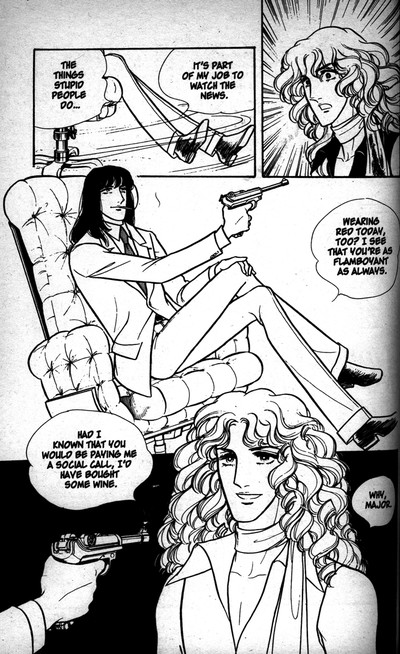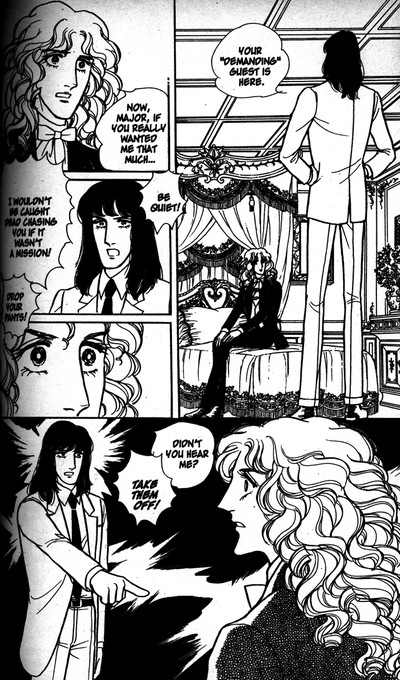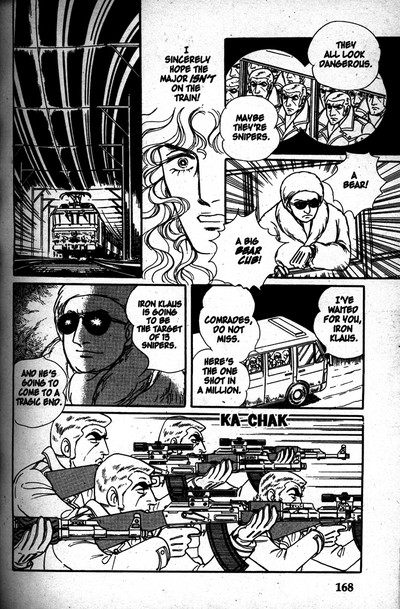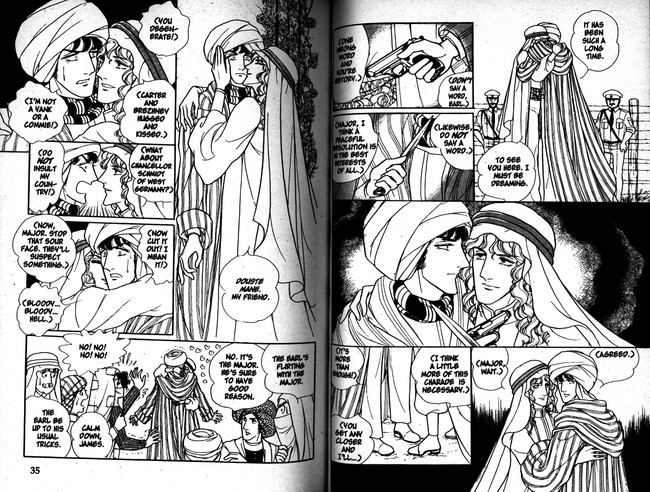Jason Thompson's House of 1000 Manga - From Eroica With Love
by Jason Thompson,
Episode XXX: From Eroica with Love
"You had to get in my way, as usual. And now I have to ride your butt - again."
— Major Klaus Heinz von dem Eberbach, From Eroica with Love

CMX, CMX, CMX… How did you release so many strange manga? What other company dared release so many uncommercial '70s and '80s shojo stories? Did you truly think that From Eroica with Love, Moon Child and Swan might become commercial bestsellers in America? Or was there some fan on your staff who thought, "Screw it, we're not going to make money with most of these manga anyway, so I'm just going to publish my favorite manga and hope that DC Comics pays for it?" If it's the former, that was highly unwise. If it's the latter: step forward and identify yourself, former CMX employee. You're awesome. I want to buy you a drink.
Despite its low sales, though, From Eroica with Love got respect from bloggers and manga critics. In fact, this proto-yaoi spy-espionage spectacular it is such a "classic" manga that I resisted reading it for a long time. Like Charles Dickens, Shakespeare and Ernest Hemingway, it was intimidatingly classy, and I figured that if I really wanted to know about it, I could always ask some other blogger. But when I finally read it, I wasn't disappointed. At least not after the first chapter.
For the first 60 pages or so, From Eroica with Love is the story of three WASPy psychic teenagers who solve crimes. Their names are Sugar Plum (the narrator, a girl with super-senses), Leopard Solid (a boy with super-strength), and Caesar Gabriel (a super-smart bishonen). Man, it must be so fun making up fake Western names if you're a Japanese mangaka! (To be fair, sometimes I think even the silliest Western name exists in real life. Which reminds me, how come Conan O'Brien can have an American TV show named after himself without getting sued by the Conan the Barbarian estate, but Detective Boy Conan can't?) While at an art gallery oohing and aahing over Bronzini's highly suggestive painting Venus, Cupid, Folly and Time, the three superteens meet Dorian Red, Earl of Gloria, an exquisitely handsome art connoisseur with outrageously long curly golden hair. "That's Cupid in the form of a gorgeous 20-year-old!" thinks Sugar Plum. She compares his dazzling beauty to the Greek sun-god Apollo.
But when a series of paintings and statues are stolen from art galleries all around the world, the three teens realize the truth: the Earl is a master art thief, the leader of a gang of criminals! Our unbearably perky heroes jump into the Mystery Machine go looking for clues to stop him before his next heist. But the openly gay Earl is not just interested in the inanimate arts; he has taken a fancy to Caesar Gabriel, a shy, virginal young nerd. And what the Earl wants, he gets. Earl kidnaps Gabriel and tries to have his way with him in his castle as his friends race to save him. ("I've never even kissed a girl.No way is my first kiss going to be with a bloke!" "Your first kiss? Marvelous. Consider yourself the luckiest man in the world to receive it from me then.") Chaos ensues. When it's all over, good is triumphant, but the Earl escapes in his private submarine, leaving stolen treasures…and stolen hearts…in his wake.
Sounds great, huh? If it actually sounds really dumb, that's okay, because in the second chapter, everything changes. The focus of the story switches completely to the Earl and his heists. Sugar Plum and Leopard Solid, and their stupid names, vanish from the manga immediately. Caesar Gabriel vanishes shortly afterward. You have to wonder what happened. My guess is that Aoike was asked by her editors to do a story with teenage characters (because it's closer to the age group of the shojo target readership) and with ESP (because ESP was popular in the '70s), and only after the reader surveys came in saying "The Earl is hot!" was she allowed to tell the story she really wanted to tell. Editors like to play it safe.

Thus, in the middle of volume 1, From Eroica with Love really begins. A new "good guy" (I use the term loosely) is introduced on the trail of the mysterious Earl. He is Major Klaus Heinz von dem Eberbach, aka "Iron Klaus", an aristocratic West German agent of NATO, which in the '70s, before the collapse of the Soviet Union, was still a big deal. Klaus is everything the Earl is not: disciplined, serious, cold. He dislikes homosexuals, and he isn't a fan of women either. Indeed, his standards of conduct are so high he dislikes almost everybody. The only thing he admits finding beautiful is "the color of polished steel." When Klaus and the Earl meet for the first time unaware of who the other is, they hate each other on sight; the Earl hates Klaus's fancy sportscars and sleeveless shirts, and Klaus hates the Earl's rudeness and lack of aesthetics. "I hate that man. His values run utterly counter to mine," thinks the Earl. "I will not give him the satisfaction of giving him anything. Period!!" thinks Klaus. They meet as enemies, and their first encounter ends with the Earl driving away in a lamborghini while Klaus chases them in a tank. But before too long, by the most unlikely concidences, they have to work together, and a buddy film match made in heaven begins. Except when they can't take it any longer and end up fighting again.
This is From Eroica with Love: a manga about a really tough, sexless, humorless German military officer and a really flamboyant, swishy English super-thief and their wacky, sexually charged espionage adventures. The sexual tension between the Earl and Klaus works because Aoike plays her cards so carefully, keeping the two leads' relationship very dry and platonic. I don't mean "there is no sexual tension and it's all made up by dôjinshi artists," like the count and the detective in Petshop of Horrors. Earl and Klaus argue, fight and genuinely dislike each other, but there's definitely something there. At least on the Earl's side. "I find the idea of English roses twirled around a hard German wire to be rather delicious with its sadistic overtones, don't you?" the Earl teases Klaus at one point. But on other occasions, Klaus just plain pisses him off. Indeed, Klaus's total jerkiness and stubbornness -- his impenetrability, if you will -- is the biggest constant in the series. Klaus is no frail seme waiting to be mastered by the Earl, he's a badass military officer and super-spy, dammit! Who is the seme and who is the uke, anyway? It's hard to tell because they are both such studs (though Klaus gradually becomes the more badass one as the manga progresses). Indeed, this is one of those rare Boy's-Love-esque manga where everyone is a manly man. Even Caesar, the Earl's original love interest, gets quickly kicked out of the manga because he's just too much of a crybaby to hang out with these two hunks. ("I leave Caesar in your good hands. Do please teach him to be more of a man," the Earl writes on a note he leaves with Caesar when he finally dumps him.)

The other thing about From Eroica with Love is that it is really a genuine espionage/adventure manga. The plots may have their silly moments, but after volume 1, they are fairly complicated, if over-the-top, spy heists. Sanami Matoh's Fake and Makoto Tateno's Yellow focused on the Boy's Love sexual tension and (IMHO) cheaped out on the spy/detective side of the story, but From Eroica with Love has lots of twists and turns and super-spy action. The premise is grounded in the Cold War between the U.S. and the Soviet Union (some volumes of the CMX edition include some helpful historical information for modern readers), but like Golgo 13, the characters travel around the world to all sorts of hotspots, whether it's war-torn Serbo-Croatia, Iran after the Iranian Revolution, or the Vatican vaults. Like Austin Powers, it's a sort of parody of James Bond movies, sometimes very specifically; in one chapter the Earl flies over a guarded compound in a helicopter and uses knockout gas to incapacitate the NATO soldiers (like in the James Bond movie Goldfinger), and the Earl's catchphrase that he leaves at the scene of his crimes, "From Eroica with Love," is not only the title of the magna but a reference to From Russia with Love, of course. Sinister Russian agents try to kill Klaus, and rival thieves interfere with the Earl's plots. A typical plot hinges on the unlikely coincidence that both Klaus and the Earl have to go to some politically tense location, Klaus trying to protect something and the Earl trying to steal something, or both of them trying to steal the same thing (in Klaus's case, for reasons of national security, of course). The Earl is a kaitô, a phantom thief, a standard manga genre character, but unlike most kaitô he really has to work for his thefts.
Like most kaitô, though, the Earl focuses on artwork because he's too noble to steal for mere reasons of money. Indeed, the manga never loses the focus on fine art; Aoike is clearly an art fan, and loves to write plot points involving Johannes Vermeer, Lucas Cranach and other classical painters. At least it's not one of those manga where the thief has to steal demon-possessed artwork to save people from its baleful influence (Kamikaze Kaitô Jeanne, March Story, etc.), an excuse I'd love to hear in an actual court case, or maybe in a manga about someone who uses a bolt cutter to steal demon-possessed bicycles. (Or maybe a manga about someone who has to steal demonically possessed books from public libraries and burn them. I'm sure it'd be a hit with Banned Books Week.)
Despite a number of comedic side characters—mostly Klaus and the Earl's henchmen, such as the Earl's annoying penny-pinching gay accountant James—From Eroica with Love is basically a two-character show. The Earl, with his long, golden locks and poet shirts, is the artsy one. He is based on Led Zeppelin vocalist Robert Plant -- the way he looked in the late '70s, that is, like this, not the way he looks today. His henchmen are also named after Led Zeppelin members, and they ride a submarine called the "Aqua Zep." In contrast, Klaus seems to be based on an archetype rather than on anybody in particular. He is The Cold Asexual Badass in a Military Uniform. (To quote the Earl: "I do like army uniforms in some ways. I find them manly and stoic. A bit of a turn-on, frankly. Enough so that I'd want to strip off a good and proper uniform and get to what's underneath.") Klaus's rigid demeanour, his love of military uniforms and his overwhelming Deutschland-iness suggests one infamous 20th century German political movement, and it's not the Green Party. In one particularly exasperated moment, the Earl fumes about Klaus: "That man with dangerous thoughts about creating a military state! That paranoid sadist who gets his kicks from weapons!" But in contrast to other Boy's Love mangaka like Minami Ozaki, Aoike never goes into actual Nazi fetishism territory. In fact, it's a plot point that Klaus hates Nazis, and gets furious when people compare him to one. Perhaps it's out of a sense of political responsibility that Aoike does her best to make Klaus an embodiment of all the cool stereotypes about Germans (Prussian rigor, discipline, mechanical-industrial technocratic awesomeness, etc.) while eliminating the bad stuff. (IMHO, one of the only failings of the CMX translation is that they don't give Klaus any Germanic dialogue, instead giving him English slang like "bloody wankers.")

Indeed, all the Eroica characters are more or less "friendly stereotypes"—Klaus represents Germany, the Earl represents Britain—making the series a tiny bit like Hetalia in its appeal. One story takes place at an East-West peace conference, where the representatives of Russia, Germany, the U.S. and England start out with honeyed words and degenerate into name-calling when the cameras aren't rolling. ("That lousy kraut!" "That slimy commie!" "Yankee, go home! Go home, you imperialist swine!" "Nazi bastard!" "Gestapo dog!") Everyone is mocked equally.
Gunfire, explosions, car chases, train chases…classical art references…hot men in uniform getting close and not quite making out…yeah, that is From Eroica with Love. Yasuko Aoike, the mangaka of this fun indulgence, is one of the many famous "Showa Year 24" shojo mangaka born around 1948 or 1949, who revolutionized shojo manga in the '70s. (The others include Moto Hagio, Keiko Asamiya, etc.) She drew a variety of manga since her teenage debut (some of her older characters make a cameo in Eroica volume 1), but at 36 volumes and ongoing, Eroica is her life's work. She has taken lengthy breaks to work on other stories, but today, 30 years after it started, she's still crankin' out From Eroica with Love stories for the magazine Princess Gold. The heroes' chins and hairstyles just keep getting bigger and bigger. But like so many manga and comic book characters - like Golgo 13 and Batman and all the other immortals - they just don't age.
CMX managed to release 15 volumes - at least that's the last one I could find - of From Eroica with Love - before their curtain call earlier this summer. Eroica leaves behind a ton of online reviews, and a cobwebby but adoring fanpage, eroicafans.org, maintained by one Lisa C. Williams. Although it hasn't been updated since 2005, eroicafans.org is notable for having something I miss in manga fandom - detailed summaries of the plots. (It's a good way to get an idea of the manga, it's got an element of creativity, and unlike scanlations, it's totally legal!) I have to say, though, that I prefer CMX's translations of Klaus' homophobic remarks ("degenerate", "slime", etc.) as opposed to the fanpage's translations, which uses more realistic, fighting-word insults ("fucking queer"). The real-world spy details in Eroica are nice, but too much real-world homophobia seems inappropriately harsh and takes me too far out of the mood of this manga. (I have a similar problem with some other Boy's Love manga, such as Hinako Takanaga's otherwise pretty hot The Tyrant Falls in Love.) Eroica is all about elegance, after all, elegance and class and fine art mixed with campy sex jokes. I was just thinking how appropriate it is that this review is "House of 1000 Manga" number XXX.
Jason Thompson is the author of Manga: The Complete Guide and King of RPGs, as well as manga editor for Otaku USA magazine.
Banner designed by Lanny Liu.
discuss this in the forum (17 posts) |
this article has been modified since it was originally posted; see change history